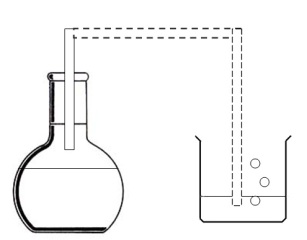- Ground helium balloons with a bunch of grapes. Then remove 1 grape at a time until the buoyant & gravitational forces balance out. The balloons will be suspended in the air. Children quickly catch on and have injected a little science into an otherwise dull wedding reception.
- Add copper to HCl & watch nothing happen. Add Cu to HNO3, & NO2 or NO forms, depending on the acid’s concentration. Add CuO to citric acid, wait a few days & a (patina-like?) material forms.
 To a beaker, add sand and a 50% solution of methanol. Then add spatula tips of zinc oxide powder. Close lights. Transitions are very temperature-dependent and different parts of the flame create a variety of colors. Students prefer demo to drugs.
To a beaker, add sand and a 50% solution of methanol. Then add spatula tips of zinc oxide powder. Close lights. Transitions are very temperature-dependent and different parts of the flame create a variety of colors. Students prefer demo to drugs.- Add calcium to water & phenolphthalein. Collect H2. Ignite it. Color change in solution reveals hydroxide formation. White precipitate of CaO settles below fuchsia solution. Filter it. Blow into solution of Ca(OH)2 to form CaCO3. More CO2 forms acid, gets rids of cloudiness.
 Add 2 drops of bromothymol blue to a (pH ~ 4) solution in a flat-bottomed flask. Add dilute NaOH to beaker. Bring the flask to a boil for 3-5 minutes. Remove heat source & wrap a cold, wet rag around the flask. Be awed by work of ΔPV.
Add 2 drops of bromothymol blue to a (pH ~ 4) solution in a flat-bottomed flask. Add dilute NaOH to beaker. Bring the flask to a boil for 3-5 minutes. Remove heat source & wrap a cold, wet rag around the flask. Be awed by work of ΔPV.- Get a hand-held digital microscope. Use it to reveal the sensuous surface of a grapefruit, an aborted seed; and the oxidation of copper on an old penny.

Chip off 5 samples from a boulder. Mass each rock.Use water displacement in large cylinder to find the volume of each piece. Obtain average density. With latter & an estimate of the boulder’s volume, get an estimate of the boulder’s mass.
8. Get a thin flow from a water tap. Wrap cotton shirt around a plastic comb. Rub it. Move the comb towards the water without touching it. Watch the stream bend like a banana. Water is neutral, but something charged within it is attracted to the oppositely charged comb.

9. Demonstrate that old pieces of magnesium often won’t flash in a Bunsen burner flame. Their surface has reacted with air. Wipe a piece with a paper towel that’s wet with dilute acid. Dry, weigh, ignite& look away! After it flashes, reveal that white residue’s mass > than original.
10.

Add two drops of bromothymol blue to 4 different test tubes containing tap water. Add distilled water to the 1st; it remains green. Add baking soda to 2nd, get blue. To the 3rd and 4th add vinegar & dry ice (CO2). Both go yellow as both additives lead to H+.
11. Ignite a hydrogen-filled balloon. Note red color from excess H2 incandescing in heat of reaction. Fill a 2nd balloon with 2:1 ratio of H2 to O2 & ignite; observe no red color. Fill 3rd balloon with hydrogen and add a little copper sulfate. Explosion becomes green-colored.
12. Spread a few grams of iron filings on a filter paper. Place it a magnetic stirrer. Turn it on at medium speed. A beautiful display of a magnetic field in motion ensues. It resembles a living colony of microorganisms.
13. The calcium carbonate in blackboard chalk is long-baked, so it quickly settles, and more stays out of the respiratory system. Yet, if you examine any ledge or border high above the board, it fills with chalk dust over the school year. How? Brownian motion.
More to come…
14. Imagine someone who has wronged you. Imagine taking a wet sheet of newspaper& sticking it on the guy’s windshield on a cold day. Due to H-bonding he’ll never be able to scrape it off, unless he has access to hot water. Imagine writing on the paper, “Revenge is best served cold.” 🙂










